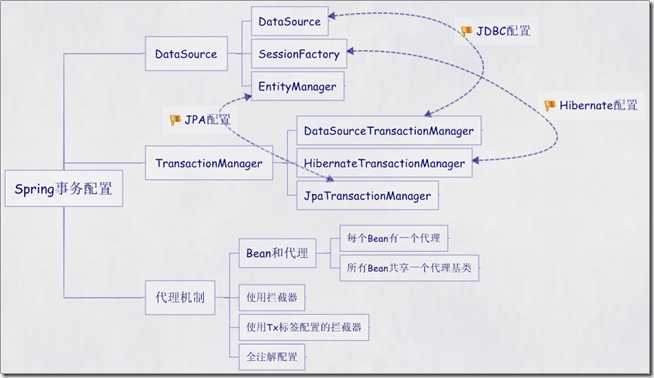DataSource、TransactionManager这两部分只是会根据数据访问方式有所变化,比如使用Hibernate进行数据访问时,DataSource实际为SessionFactory,TransactionManager的实现为HibernateTransactionManager。
具体如下图:
根据代理机制的不同,总结了五种Spring事务的配置方式,配置文件如下:
第一种方式:每个Bean都有一个代理
< beans xmlns ="http://www.springframework.org/schema/beans"
xmlns:xsi ="http://www.w3.org/2001/XMLSchema-instance"
xmlns:context ="http://www.springframework.org/schema/context"
xmlns:aop ="http://www.springframework.org/schema/aop"
xsi:schemaLocation ="http://www.springframework.org/schema/beans
http://www.springframework.org/schema/beans/spring-beans-2.5.xsd
http://www.springframework.org/schema/context
http://www.springframework.org/schema/context/spring-context-2.5.xsd
http://www.springframework.org/schema/aop http://www.springframework.org/schema/aop/spring-aop-2.5.xsd" >
< bean id ="sessionFactory"
class ="org.springframework.orm.hibernate3.LocalSessionFactoryBean" >
< property name ="configLocation" value ="classpath:hibernate.cfg.xml" />
< property name ="configurationClass" value ="org.hibernate.cfg.AnnotationConfiguration" />
</ bean >
<!-- 定义事务管理器(声明式的事务) -->
< bean id ="transactionManager"
class ="org.springframework.orm.hibernate3.HibernateTransactionManager" >
< property name ="sessionFactory" ref ="sessionFactory" />
</ bean >
<!-- 配置DAO -->
< bean id ="userDaoTarget" class ="com.bluesky.spring.dao.UserDaoImpl" >
< property name ="sessionFactory" ref ="sessionFactory" />
</ bean >
< bean id ="userDao"
class ="org.springframework.transaction.interceptor.TransactionProxyFactoryBean" >
<!-- 配置事务管理器 -->
< property name ="transactionManager" ref ="transactionManager" />
< property name ="target" ref ="userDaoTarget" />
< property name ="proxyInterfaces" value ="com.bluesky.spring.dao.GeneratorDao" />
<!-- 配置事务属性 -->
< property name ="transactionAttributes" >
< props >
< prop key ="*" > PROPAGATION_REQUIRED </ prop >
</ props >
</ property >
</ bean >
</ beans >
第二种方式:所有Bean共享一个代理基类
< beans xmlns ="http://www.springframework.org/schema/beans"
xmlns:xsi ="http://www.w3.org/2001/XMLSchema-instance"
xmlns:context ="http://www.springframework.org/schema/context"
xmlns:aop ="http://www.springframework.org/schema/aop"
xsi:schemaLocation ="http://www.springframework.org/schema/beans
http://www.springframework.org/schema/beans/spring-beans-2.5.xsd
http://www.springframework.org/schema/context
http://www.springframework.org/schema/context/spring-context-2.5.xsd
http://www.springframework.org/schema/aop http://www.springframework.org/schema/aop/spring-aop-2.5.xsd" >
< bean id ="sessionFactory"
class ="org.springframework.orm.hibernate3.LocalSessionFactoryBean" >
< property name ="configLocation" value ="classpath:hibernate.cfg.xml" />
< property name ="configurationClass" value ="org.hibernate.cfg.AnnotationConfiguration" />
</ bean >
<!-- 定义事务管理器(声明式的事务) -->
< bean id ="transactionManager"
class ="org.springframework.orm.hibernate3.HibernateTransactionManager" >
< property name ="sessionFactory" ref ="sessionFactory" />
</ bean >
< bean id ="transactionBaseProxy"
class ="org.springframework.transaction.interceptor.TransactionProxyFactoryBean"
lazy-init ="true" abstract ="true" >
<!-- 配置事务管理器 -->
< property name ="transactionManager" ref ="transactionManager" />
<!-- 配置事务属性 -->
< property name ="transactionAttributes" >
< props >
< prop key ="*" > PROPAGATION_REQUIRED </ prop >
</ props >
</ property >
</ bean >
<!-- 配置DAO -->
< bean id ="userDaoTarget" class ="com.bluesky.spring.dao.UserDaoImpl" >
< property name ="sessionFactory" ref ="sessionFactory" />
</ bean >
< bean id ="userDao" parent ="transactionBaseProxy" >
< property name ="target" ref ="userDaoTarget" />
</ bean >
</ beans >
第三种方式:使用拦截器
< beans xmlns ="http://www.springframework.org/schema/beans"
xmlns:xsi ="http://www.w3.org/2001/XMLSchema-instance"
xmlns:context ="http://www.springframework.org/schema/context"
xmlns:aop ="http://www.springframework.org/schema/aop"
xsi:schemaLocation ="http://www.springframework.org/schema/beans
http://www.springframework.org/schema/beans/spring-beans-2.5.xsd
http://www.springframework.org/schema/context
http://www.springframework.org/schema/context/spring-context-2.5.xsd
http://www.springframework.org/schema/aop http://www.springframework.org/schema/aop/spring-aop-2.5.xsd" >
< bean id ="sessionFactory"
class ="org.springframework.orm.hibernate3.LocalSessionFactoryBean" >
< property name ="configLocation" value ="classpath:hibernate.cfg.xml" />
< property name ="configurationClass" value ="org.hibernate.cfg.AnnotationConfiguration" />
</ bean >
<!-- 定义事务管理器(声明式的事务) -->
< bean id ="transactionManager"
class ="org.springframework.orm.hibernate3.HibernateTransactionManager" >
< property name ="sessionFactory" ref ="sessionFactory" />
</ bean >
< bean id ="transactionInterceptor"
class ="org.springframework.transaction.interceptor.TransactionInterceptor" >
< property name ="transactionManager" ref ="transactionManager" />
<!-- 配置事务属性 -->
< property name ="transactionAttributes" >
< props >
< prop key ="*" > PROPAGATION_REQUIRED </ prop >
</ props >
</ property >
</ bean >
< bean class ="org.springframework.aop.framework.autoproxy.BeanNameAutoProxyCreator" >
< property name ="beanNames" >
< list >
< value > *Dao </ value >
</ list >
</ property >
< property name ="interceptorNames" >
< list >
< value > transactionInterceptor </ value >
</ list >
</ property >
</ bean >
<!-- 配置DAO -->
< bean id ="userDao" class ="com.bluesky.spring.dao.UserDaoImpl" >
< property name ="sessionFactory" ref ="sessionFactory" />
</ bean >
</ beans >
第四种方式:使用tx标签配置的拦截器
< beans xmlns ="http://www.springframework.org/schema/beans"
xmlns:xsi ="http://www.w3.org/2001/XMLSchema-instance"
xmlns:context ="http://www.springframework.org/schema/context"
xmlns:aop ="http://www.springframework.org/schema/aop"
xmlns:tx ="http://www.springframework.org/schema/tx"
xsi:schemaLocation ="http://www.springframework.org/schema/beans
http://www.springframework.org/schema/beans/spring-beans-2.5.xsd
http://www.springframework.org/schema/context
http://www.springframework.org/schema/context/spring-context-2.5.xsd
http://www.springframework.org/schema/aop http://www.springframework.org/schema/aop/spring-aop-2.5.xsd
http://www.springframework.org/schema/tx http://www.springframework.org/schema/tx/spring-tx-2.5.xsd" >
< context:annotation-config />
< context:component-scan base-package ="com.bluesky" />
< bean id ="sessionFactory"
class ="org.springframework.orm.hibernate3.LocalSessionFactoryBean" >
< property name ="configLocation" value ="classpath:hibernate.cfg.xml" />
< property name ="configurationClass" value ="org.hibernate.cfg.AnnotationConfiguration" />
</ bean >
<!-- 定义事务管理器(声明式的事务) -->
< bean id ="transactionManager"
class ="org.springframework.orm.hibernate3.HibernateTransactionManager" >
< property name ="sessionFactory" ref ="sessionFactory" />
</ bean >
< tx:advice id ="txAdvice" transaction-manager ="transactionManager" >
< tx:attributes >
< tx:method name ="*" propagation ="REQUIRED" />
</ tx:attributes >
</ tx:advice >
< aop:config >
< aop:pointcut id ="interceptorPointCuts"
expression ="execution(* com.bluesky.spring.dao.*.*(..))" />
< aop:advisor advice-ref ="txAdvice"
pointcut-ref ="interceptorPointCuts" />
</ aop:config >
</ beans >
第五种方式:全注解
< beans xmlns ="http://www.springframework.org/schema/beans"
xmlns:xsi ="http://www.w3.org/2001/XMLSchema-instance"
xmlns:context ="http://www.springframework.org/schema/context"
xmlns:aop ="http://www.springframework.org/schema/aop"
xmlns:tx ="http://www.springframework.org/schema/tx"
xsi:schemaLocation ="http://www.springframework.org/schema/beans
http://www.springframework.org/schema/beans/spring-beans-2.5.xsd
http://www.springframework.org/schema/context
http://www.springframework.org/schema/context/spring-context-2.5.xsd
http://www.springframework.org/schema/aop http://www.springframework.org/schema/aop/spring-aop-2.5.xsd
http://www.springframework.org/schema/tx http://www.springframework.org/schema/tx/spring-tx-2.5.xsd" >
< context:annotation-config />
< context:component-scan base-package ="com.bluesky" />
< tx:annotation-driven transaction-manager ="transactionManager" />
< bean id ="sessionFactory"
class ="org.springframework.orm.hibernate3.LocalSessionFactoryBean" >
< property name ="configLocation" value ="classpath:hibernate.cfg.xml" />
< property name ="configurationClass" value ="org.hibernate.cfg.AnnotationConfiguration" />
</ bean >
<!-- 定义事务管理器(声明式的事务) -->
< bean id ="transactionManager"
class ="org.springframework.orm.hibernate3.HibernateTransactionManager" >
< property name ="sessionFactory" ref ="sessionFactory" />
</ bean >
</ beans >
此时在DAO上需加上@Transactional注解,如下:
import java.util.List;
import org.hibernate.SessionFactory;
import org.springframework.beans.factory.annotation.Autowired;
import org.springframework.orm.hibernate3.support.HibernateDaoSupport;
import org.springframework.stereotype.Component;
import com.bluesky.spring.domain.User;
@Transactional
@Component( " userDao " )
public class UserDaoImpl extends HibernateDaoSupport implements UserDao {
public List < User > listUsers() {
return this .getSession().createQuery( " from User " ).list();
}

}
|
注意的几点: 1 @Transactional 只能被应用到public方法上, 对于其它非public的方法,如果标记了@Transactional也不会报错,但方法没有事务功能.
2 默认情况下,一个有事务方法, 遇到RuntiomeException 时会回滚 . 遇到 受检查的异常 是不会回滚 的. 要想所有异常都回滚,要加上 @Transactional( rollbackFor={Exception.class,其它异常}) .
@Transactional 的所有可选属性如下:
事务的隔离级别 有如下可选: 可以去看spring源码 : org.springframework.transaction.annotation.Isolation 我的"隔离级别"相关文章 有不明白的,可以去看看.
事务的传播属性 ,有如下可选 可以去看spring源码 : org.springframework.transaction.annotation.Propagation
|
数据库提供了四种事务隔离级别, 不同的隔离级别采用不同的锁类开来实现.
在四种隔离级别中, Serializable的级别最高, Read Uncommited级别最低.
大多数数据库的默认隔离级别为: Read Commited,如Sql Server , Oracle.
少数数据库默认的隔离级别为Repeatable Read, 如MySQL InnoDB存储引擎
即使是最低的级别,也不会出现 第一类 丢失 更新问题 .
- Read Uncommited :读未提交数据( 会出现脏读,不可重复读,幻读 ,避免了 第一类丢失 更新 )
- Read Commited :读已提交的数据(会出现不可重复读,幻读)
- Repeatable Read :可重复读(会出现幻读)
- Serializable :串行化
丢失 更新 :
当两个或多个事务选择同一行,然后基于最初选定的值更新该行时,会发生丢失更新问题。每个事务都不知道其它事务的存在。最后的更新将重写由其它事务所做的更新,这将导致数据丢失。
例:
事务A和事务B同时修改某行的值,
1.事务A将数值改为1并提交
2.事务B将数值改为2并提交。
这时数据的值为2,事务A所做的更新将会丢失。
解决办法:对行加锁,只允许并发一个更新事务。
脏读: 一个事务读到另一个事务未提交的更新数据
例:
1.Mary的原工资为1000, 财务人员将Mary的工资改为了8000(但未提交事务)
2.Mary读取自己的工资 ,发现自己的工资变为了8000,欢天喜地!
3.而财务发现操作有误,回滚了事务,Mary的工资又变为了1000, 像这样,Mary记取的工资数8000是一个脏数据。
不可重复读: 在同一个事务中,多次读取同一数据,返回的结果有所不同. 换句话说就是,后续读取可以读到另一个事务已提交的更新数据. 相反"可重复读"在同一事务多次读取数据时,能够保证所读数据一样,也就是后续读取不能读到另一事务已提交的更新数据.
例:
1.在事务1中,Mary 读取了自己的工资为1000,操作并没有完成
2.在事务2中,这时财务人员修改了Mary的工资为2000,并提交了事务.
3.在事务1中,Mary 再次读取自己的工资时,工资变为了2000
解决办法:如果只有在修改事务完全提交之后才可以读取数据,则可以避免该问题。
幻读: 一个事务读取到另一个事务已提交的insert数据.
例:
第一个事务对一个表中的数据进行了修改,这种修改涉及到表中的全部数据行。同时 (此时第一事务还未提交) ,第二个事务向表中插入一行新数据。这时第一个事务再去读取表时,发现表中还有没有修改的数据行,就好象发生了幻觉一样。






















 237
237

 被折叠的 条评论
为什么被折叠?
被折叠的 条评论
为什么被折叠?








